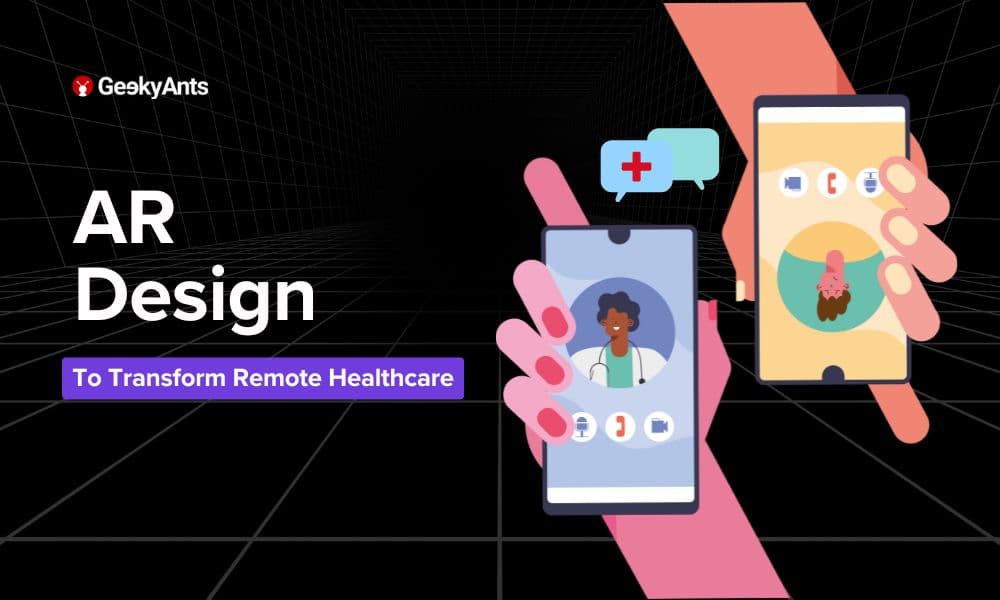Table of Contents
AR Design in Telehealth and Telemedicine Apps: Transforming Remote Healthcare
Author

Subject Matter Expert

Date

Book a call
Augmented Reality (AR) is becoming indispensable in telehealth and telemedicine apps, offering more than just convenience—it’s redefining how healthcare is delivered remotely. Unlike traditional video calls, AR is an interactive digital element in real-world visuals, that provides healthcare professionals with enhanced tools to assess and treat patients from a distance. This immersive technology allows for clearer communication, improved diagnostics, and more accurate guidance during virtual consultations.
In telehealth, AR transforms what was once a passive consultation into an active, hands-on exchange.
AR in telehealth enables doctors to visualize complex medical data in real-time, interact with patient information more intuitively, and even offer step-by-step support as if they were physically present.
This evolution is pushing the boundaries of remote care, offering richer and more effective healthcare experiences that unlock new opportunities for business growth in telemedicine.
Augmented Reality (AR) Trends in Healthcare
In healthcare, the use of Augmented Reality (AR) is unlocking new levels of innovation that were once hard to imagine. It’s not just about technology for technology’s sake—AR is creating real value by transforming patient care, from surgeries to rehabilitation. For business leaders, it’s about recognizing how AR can streamline operations, cut costs, and improve outcomes.
Here are five key AR trends reshaping healthcare:
- Robotic-Assisted Surgery (RAS)
AR is enhancing robotic surgeries by providing surgeons with real-time, 3D visuals during procedures. This precision not only improves surgical accuracy but also minimizes the risk of human error, resulting in better patient outcomes and more streamlined operations. - Advanced Wound Care
AR empowers medical professionals to remotely monitor wounds using non-invasive imaging techniques. Offering detailed visual assessments helps track healing progress more effectively, allowing clinicians to make faster, more informed decisions without the need for frequent in-person visits. - Interactive Rehabilitation
AR tools are transforming rehabilitation by delivering real-time guidance and personalized feedback. Whether aiding post-operative recovery or physical therapy, AR-based exercises engage patients more conveniently, while healthcare providers monitor their progress from a distance with enhanced accuracy. - Enhanced Medical Training
AR is elevating medical education by creating immersive training environments. Students can now simulate high-stakes procedures with incredible realism, building their skills safely and cost-effectively. This hands-on experience is driving faster learning and reducing the risks associated with direct patient training. - Seamless Hospital Navigation
Navigating complex healthcare facilities becomes far easier with AR-powered apps. These tools provide real-time guidance, helping patients find their way with ease and reducing missed or delayed appointments. This approach not only improves the patient journey but also optimizes the overall efficiency of healthcare facilities.
Benefits of AR in Telehealth and Telemedicine
Augmented Reality (AR) is revolutionizing telehealth and telemedicine, creating a bridge between physical and virtual care that enhances the quality of interactions and the precision of treatment.
For business leaders, AR isn't just another technology—it's a strategic advantage in making healthcare more dynamic and patient-centered. Let’s break down five key ways AR is pushing the boundaries of remote care:
- Transforming Virtual Consultations into Hands-On Experiences
Traditional virtual consultations are limited to voice and video, but AR introduces a new depth of interaction. Imagine a doctor guiding a patient through their treatment plan while visualizing the patient’s anatomy in 3D right on their screen. This makes explaining complex medical conditions much simpler and allows patients to see their treatment paths more clearly. It turns a static conversation into an engaging, hands-on experience, helping patients feel more connected and informed about their care. - Precision Diagnostics From Afar
Diagnosing patients remotely has always been one of telemedicine's greatest challenges. AR changes this by enabling doctors to access real-time, 3D data on patients’ vital signs and medical history, all in an immersive format. For instance, AR devices could allow physicians to view internal structures like veins or organs during a remote consultation, aiding in diagnostics that previously required physical exams. The result? More accurate diagnoses without the need for physical presence. - Collaborative Healthcare Across Locations
AR is also enabling a new level of collaboration among healthcare providers, regardless of where they are located. Specialists across the globe can now join surgeries or complex procedures remotely, viewing real-time AR overlays of the patient's condition and providing guidance as if they were in the room. This level of collaboration makes high-quality care accessible in more places, reducing the need for patients to travel to specialists, and ensuring that expertise is always within reach. - Interactive Patient Education and Engagement
Keeping patients engaged with their health is one of AR's most powerful contributions to telehealth. Through AR applications, patients can visualize the effects of treatments or track their recovery progress in real-time. Whether it's an interactive AR exercise plan for a patient in rehabilitation or a 3D demonstration of a surgical procedure, AR keeps patients informed and actively involved in their care journey, resulting in better adherence to treatment plans and improved outcomes. - Seamless Remote Monitoring and Long-Term Care
For chronic conditions, AR-enabled telemedicine offers continuous monitoring without disrupting patients’ daily lives. Wearable AR devices can track important health metrics and send real-time updates to doctors, allowing them to monitor patients from afar. This creates an opportunity for more proactive care—intervening when necessary without waiting for a scheduled appointment—resulting in more responsive, personalized healthcare management.
How AR Improves User Experience in Telemedicine Apps
Augmented Reality (AR) is elevating the telemedicine experience by making healthcare interactions more intuitive and immersive. AR in telemedicine apps does not just add a layer of visual excitement—it fundamentally transforms how patients interact with their healthcare providers, making remote care more personalized, efficient, and impactful.
Here’s how AR is driving a better user experience in telemedicine:
Making Remote Diagnostics More Interactive
Telemedicine can feel impersonal, but AR adds a layer of depth that’s otherwise missing. Picture a patient on a video call with their doctor, worried about a heart condition. AR allows the doctor to project a detailed 3D model of the patient’s heart right into the video consultation.
Use Case: A cardiologist can display a live 3D heart model, using it to show exactly how the condition is affecting the patient.
Example: Instead of just talking about how a valve isn’t closing properly, the doctor rotates the virtual heart, visually highlighting the problem in real-time, offering the patient a far better understanding of their health.
Personalized Recovery Through AR-Assisted Rehab
Rehabilitation is crucial after surgeries, but many patients struggle to follow exercises correctly on their own. AR steps in by guiding patients through every movement. Imagine a patient recovering from knee surgery, following AR-projected exercise routines right from their living room.
Use Case: A post-surgery patient uses an AR app that overlays exercise instructions onto their environment, ensuring each move is performed with precision.
Example: The app gives real-time corrections, much like a virtual physiotherapist, preventing errors that could slow down recovery and reducing the need for frequent clinic visits.
Bridging the Gap Between Specialists for Better Care
One of the most exciting uses of AR is in enabling specialists to collaborate across distances. AR platforms allow specialists to share detailed medical visuals during live consultations, working together seamlessly no matter where they’re located.
Use Case: An orthopedic surgeon in Los Angeles consults with a neurologist in London, both using AR to examine the same detailed scan of a patient’s spinal injury.
Example: By manipulating a 3D spine model, they can make joint decisions on the best surgical approach, all without the patient needing to travel between clinics.
Engaging Patients Through AR Education
Patients often struggle to grasp complex medical information, but AR can help simplify things. For example, a diabetic patient trying to understand how different foods affect their blood sugar levels can use an AR app that visualizes these changes in real-time.
Use Case: A diabetic patient tracks their glucose levels with an AR app that displays the impact of their diet choices directly on their device.
Example: By scanning their meal, the app shows a real-time simulation of how their blood sugar spikes or stabilizes, helping them make better choices and manage their condition more effectively.
Real-life Applications of AR in Telehealth and Telemedicine Apps
Telemedicine has shifted from a convenient alternative to a vital part of healthcare, but Augmented Reality (AR) is taking it even further. From diagnosis to recovery, AR is giving patients and providers tools that make care more precise, engaging, and scalable. Below are some real-world examples where AR is making a significant impact.
Reimagining Remote Diagnostics
Telehealth has always been about bridging gaps, but AR is pushing the boundaries further by enabling doctors to visualize conditions in real-time. This goes beyond speaking over video; AR allows complex conditions to be mapped in 3D, making remote diagnostics more precise. This shift is transforming how health conditions are assessed—remotely but with the same clarity as being in the same room.
Guided Recovery Without Boundaries
Post-surgery recovery often comes with obstacles. AR ensures that patients are no longer struggling alone at home. With AR-enabled apps, recovery becomes a fully guided experience where every movement, stretch, and exercise is monitored in real-time. No more guessing, no more trial and error—just precise rehabilitation with instant feedback.
Global Collaboration, Local Impact
AR removes the need for specialists to travel, facilitating real-time consultations across borders. Think of it as healthcare without geographical limits, where the best minds can work together seamlessly on cases without ever leaving their respective offices. It's a new era of global healthcare collaboration, improving patient outcomes while keeping costs down.
Empowering Patients Through Visualization
Patients have always struggled to understand complex medical jargon. AR simplifies this by visually presenting their conditions and treatments in an interactive manner. Whether it’s understanding how a certain medication works or seeing how a diet plan impacts their health, AR turns abstract medical concepts into clear, visual learning experiences that empower patients.
Continuous Monitoring Without Disruption
AR, paired with wearable technology, offers an ongoing connection between patients and their doctors. Health metrics are displayed in real time, with AR-enabled insights allowing physicians to adjust treatments on the fly. This proactive approach keeps patients healthier and reduces the need for emergency interventions.
Challenges in Implementing AR in Telehealth Apps
While AR offers tremendous potential for telehealth, its implementation is not without hurdles. Here are some of the main challenges faced when integrating AR into telehealth apps:
- High Development Costs
AR technology requires significant investment in both hardware and software. Developing AR-based telehealth apps involves advanced 3D modeling, real-time data processing, and seamless integration with medical systems, all of which come at a premium. These costs can deter smaller healthcare providers from adopting AR solutions.
- Device Compatibility and Accessibility
For AR to be effective in telehealth, patients and doctors need access to AR-enabled devices, such as smartphones, tablets, or AR glasses. However, not all patients have access to the latest devices or the internet speeds necessary to support these applications, limiting the reach of AR in telemedicine.
- Data Privacy and Security Concerns
Handling sensitive medical data with AR platforms presents new security challenges. As AR requires processing of real-time health data, ensuring that this information is securely transmitted and stored while complying with HIPAA and other regulations is a significant challenge.
- Limited AR Expertise
The development and deployment of AR in healthcare require specialized skills, which are still relatively scarce. Many healthcare providers and software companies lack the expertise needed to create or maintain AR-based telehealth systems, causing delays and inefficiencies in implementation.
- Integration with Existing Healthcare Systems
Integrating AR into current healthcare infrastructures and Electronic Health Records (EHR) systems is complex. AR must work seamlessly with existing medical software, which can require custom solutions, increasing the complexity and time needed for implementation.
- User Experience and Adoption
Introducing AR into telehealth requires both doctors and patients to adopt new ways of interacting with technology. Ensuring that the user experience is intuitive and easy to navigate is critical for successful adoption, but this can be a challenge, especially for older patients or those less familiar with advanced technologies.
However, these challenges are not insurmountable—this is where GeekyAnts steps in.
How is GeekyAnts Transforming Telehealth with AR Design?
We don't just deliver technology—we create scalable, patient-centric platforms that seamlessly integrate with existing healthcare systems, minimizing disruption. At GeekyAnts, we help healthcare leaders turn AR challenges into opportunities. Our focus is on creating custom, scalable AR solutions that seamlessly integrate with existing healthcare systems, ensuring minimal disruption and maximum impact. By leveraging technologies like React Native and Node.js, we craft AR-powered apps that offer real-time diagnostics, patient monitoring, and rehabilitation that work across devices, making care accessible anywhere.
Through our GeekCare platform, we've developed a comprehensive solution that enables healthcare providers to offer HIPAA-compliant, secure data management while enhancing patient engagement through AR-driven interactions. This platform serves as a foundation that can be tailored to build similar, customized solutions for your organization, aligning with both your business goals and patient needs.
Our expertise doesn’t end with development—we provide continuous support, addressing the challenges of AR implementation in healthcare, from integration to maintenance, making AR a powerful tool for your business to drive better patient care and operational efficiency.
Future Trends in AR and Telehealth
As AR technology continues to evolve, it is poised to drive several exciting developments in telehealth. Telehealth is moving toward a future where AR not only supports patient care but also creates a more immersive, data-rich environment for both patients and providers.
Here are some forward-looking developments that business leaders should consider:
Precision Diagnostics with Real-Time 3D Imaging
AR will revolutionize remote diagnostics by providing real-time 3D imaging, allowing healthcare providers to make more accurate assessments and improve decision-making.
Wearable AR for Continuous Patient Monitoring
Wearable AR devices will enhance patient care by enabling continuous monitoring and offering real-time data for proactive interventions and better health outcomes.
AI-Driven AR for Predictive Care
AI-integrated AR will offer predictive insights, supporting healthcare professionals with data-driven decision-making during telehealth consultations.
Global AR-Assisted Surgery Collaboration
AR will facilitate global collaboration in surgeries, enabling specialists from different locations to remotely assist in procedures and enhance access to expert care.
AR in Mental Health Support
AR will play a growing role in mental health care, creating immersive environments for therapy sessions, and helping patients manage conditions like anxiety and PTSD with personalized, real-time interventions.
Hyper-Personalized Telehealth Experiences
AR will enable highly personalized telehealth interactions, offering immersive and patient-specific care, and improving engagement and patient outcomes.
These trends signal that the intersection of AR and telehealth will continue to grow, providing more personalized care, enhanced diagnostics, and global collaboration opportunities.
Conclusion
As we have explored, Augmented Reality (AR) is revolutionizing telehealth, bringing a new dimension to remote care by merging physical and digital healthcare environments. From real-time 3D diagnostics and interactive rehabilitation to global collaborations and enhanced patient education, AR is pushing telemedicine into the future.
While challenges such as development costs, device compatibility, and data privacy persist, solutions like GeekyAnts' custom AR-powered solutions are designed to overcome these barriers. As AR continues to evolve, healthcare leaders stand to gain from innovations that make patient care more precise, personalized, and scalable.
FAQs
1. How is Augmented Reality used in healthcare?
AR enhances healthcare by providing real-time, 3D visuals for diagnostics, surgeries, and patient education. It helps doctors visualize conditions better, offers guided rehabilitation, and improves patient understanding of treatment plans.
2. How can AR change telemedicine?
AR makes telemedicine more interactive, allowing for real-time visualization of patient data and offering more immersive consultations. It also enables remote diagnosis and guided care, improving the overall quality of remote healthcare.
3. Can AR reduce healthcare costs?
Yes, AR can reduce costs by minimizing the need for in-person visits, improving diagnostic accuracy remotely, and enabling better collaboration among healthcare professionals, which streamlines operations and reduces errors.
4. How much time does it take to build an AR healthcare app?
The time required depends on the complexity of features, integrations, and compliance needs, but generally, building a custom AR healthcare app can take anywhere from 3 to 6 months or more.
Dive deep into our research and insights. In our articles and blogs, we explore topics on design, how it relates to development, and impact of various trends to businesses.





